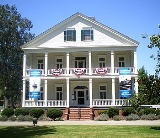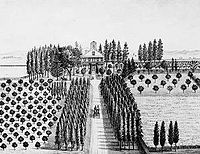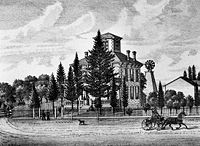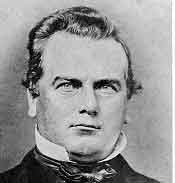
Banning House
Encyclopedia
Banning House, also known as the General Phineas Banning Residence Museum, is a historic Greek Revival
-Victorian
home in the Wilmington
section of Los Angeles, California
. Built in 1863 by Phineas Banning
near the original San Pedro Bay
, it remained in the Banning family until 1925 and has been owned by the City of Los Angeles since 1927. The home, barn and gardens are now operated as a museum
. The Banning House property has been designated as a city Los Angeles Historic-Cultural Monument
, a state California Historical Landmark
, and federally listed on the National Register of Historic Places
.

 Banning House was designed by Phineas Banning, and has been described as "one of the best examples of Greek Revival architecture in the west." It originally had 30 rooms, but some rooms have been combined, and the house now has 24 rooms. According to a history of the house written by its curator, Banning recruited help to build the house from shipwrights, blacksmith
Banning House was designed by Phineas Banning, and has been described as "one of the best examples of Greek Revival architecture in the west." It originally had 30 rooms, but some rooms have been combined, and the house now has 24 rooms. According to a history of the house written by its curator, Banning recruited help to build the house from shipwrights, blacksmith
s, carpenters, and artisans employed on clipper ships visiting the Wilmington harbor. Banning was reported to have lavishly entertained the ships' captains while they were at Wilmington, encouraging them to stay in port and seal up leaks in their ships with tar from the La Brea Tar Pits
. The story goes: "Strangely enough Banning repeated this warning (about leaky ships) over and over for about three years until his mansion was completed in 1864."
The house was a departure from the adobe haciendas that predominated in Southern California at the time and became a showplace. During Banning's life, the house was the site of parties, or "regales" as Banning called them, attended by United States senators, congressmen, governors, foreign dignitaries, ship captains, Army officers, and business leaders. It has been said that "no home in all California represents the horse and carriage era more fully than the Banning Mansion, where for decades Phineas entertained the elite of the social, economic, and political world." The house was also reportedly the site of "the first yachting party on the West Coast."
Banning arrived in Los Angeles in 1851 and built successful transportation businesses, including ships, railroads, and stage coach lines running from Wilmington to Los Angeles, San Bernardino
, and Fort Yuma
. He founded Wilmington (named after his hometown of Wilmington, Delaware
) in 1858, built the first railroad in Los Angeles (the Los Angeles and San Pedro Railroad) in 1869, designed and promoted the first breakwater at the Los Angeles harbor, and is considered the "Father of the Port of Los Angeles
." Banning was reportedly fond of walking up the stairs of the house to his fourth floor cupola where he would watch the ships arriving with cargoes. He was also elected to the California legislature in 1867 and 1869. Banning lived in the house for more than 20 years until his death in 1885. Banning died at age 53 after being knocked down and run over by a passing express wagon while visiting San Francisco
.
 After Phineas Banning died, Hancock Banning maintained the residence until his death in 1894, and the house continued to be occupied by the Banning family until 1925. In 1927, the house and grounds were purchased by the City of Los Angeles to create a city park for the residents of Wilmington. In 1934, the Los Angeles Board of Park Commissioners proposed restoring the house, and the Banning family donated many of the original furnishings and equipment. Motion picture studios, including Twentieth-Century Fox, Warner Brothers and Paramount, contributed wallpapers to conform to the Civil War era. Following the restoration, the formal dedication took place in 1936 and was attended by Governor Frank Merriam
After Phineas Banning died, Hancock Banning maintained the residence until his death in 1894, and the house continued to be occupied by the Banning family until 1925. In 1927, the house and grounds were purchased by the City of Los Angeles to create a city park for the residents of Wilmington. In 1934, the Los Angeles Board of Park Commissioners proposed restoring the house, and the Banning family donated many of the original furnishings and equipment. Motion picture studios, including Twentieth-Century Fox, Warner Brothers and Paramount, contributed wallpapers to conform to the Civil War era. Following the restoration, the formal dedication took place in 1936 and was attended by Governor Frank Merriam
, Senator William Gibbs McAdoo
, and Mayor Frank L. Shaw
. It opened to the public in 1938, closed in 1941 at the start of World War II
, and did not reopen until 1952.
The house is operated as the General Phineas Banning Residence Museum. In addition to the house and its furnishings, the museum includes a basement-level gallery with photographs depicting the history of the port, the Banning family, and Wilmington. The museum also includes a large display of 19th century stagecoach
es located in the barn and a one-room school house adjacent to the house. The gardens include eucalyptus trees (reputed to be the first to be planted in California) and large wisteria
vines planted in the late 19th Century.
The museum is open for docent-led tours Tuesday through Thursdays (12:30, 1:30 and 2:30) and Saturdays through Sundays (12:30, 1:30, 2:30 and 3:30); a $5 donation is requested for persons 12 years and older.
, receiving its listing in May 1971.
Greek Revival architecture
The Greek Revival was an architectural movement of the late 18th and early 19th centuries, predominantly in Northern Europe and the United States. A product of Hellenism, it may be looked upon as the last phase in the development of Neoclassical architecture...
-Victorian
Victorian architecture
The term Victorian architecture refers collectively to several architectural styles employed predominantly during the middle and late 19th century. The period that it indicates may slightly overlap the actual reign, 20 June 1837 – 22 January 1901, of Queen Victoria. This represents the British and...
home in the Wilmington
Wilmington, Los Angeles, California
Wilmington is a district of Los Angeles, with industry as its primary economic activity. It lies adjacent to the Port of Los Angeles, San Pedro, and Harbor City. Wilmington is the site of Banning House and Drum Barracks, or Camp Drum, the only major American Civil War landmark in California. The...
section of Los Angeles, California
Los Angeles, California
Los Angeles , with a population at the 2010 United States Census of 3,792,621, is the most populous city in California, USA and the second most populous in the United States, after New York City. It has an area of , and is located in Southern California...
. Built in 1863 by Phineas Banning
Phineas Banning
Phineas Banning was an American businessman, financier, and entrepreneur.Known as "The Father of the Port of Los Angeles," he was one of the founders of the town of Wilmington, which was named for his birthplace...
near the original San Pedro Bay
San Pedro Bay (California)
San Pedro Bay is an inlet on the Pacific Ocean coast of southern California, United States. It is the site of the Port of Los Angeles and the Port of Long Beach, which together form the fifth-busiest port facility in the world and easily the busiest in the Western Hemisphere...
, it remained in the Banning family until 1925 and has been owned by the City of Los Angeles since 1927. The home, barn and gardens are now operated as a museum
Museum
A museum is an institution that cares for a collection of artifacts and other objects of scientific, artistic, cultural, or historical importance and makes them available for public viewing through exhibits that may be permanent or temporary. Most large museums are located in major cities...
. The Banning House property has been designated as a city Los Angeles Historic-Cultural Monument
Los Angeles Historic-Cultural Monument
Los Angeles Historic-Cultural Monuments are sites in Los Angeles, California, which have been designated by the Los Angeles Cultural Heritage Commission as worthy of preservation based on architectural, historic and cultural criteria.-History:...
, a state California Historical Landmark
California Historical Landmark
California Historical Landmarks are buildings, structures, sites, or places in the state of California that have been determined to have statewide historical significance by meeting at least one of the criteria listed below:...
, and federally listed on the National Register of Historic Places
National Register of Historic Places
The National Register of Historic Places is the United States government's official list of districts, sites, buildings, structures, and objects deemed worthy of preservation...
.
History and architecture


Blacksmith
A blacksmith is a person who creates objects from wrought iron or steel by forging the metal; that is, by using tools to hammer, bend, and cut...
s, carpenters, and artisans employed on clipper ships visiting the Wilmington harbor. Banning was reported to have lavishly entertained the ships' captains while they were at Wilmington, encouraging them to stay in port and seal up leaks in their ships with tar from the La Brea Tar Pits
La Brea Tar Pits
The La Brea Tar Pits are a cluster of tar pits around which Hancock Park was formed, in the urban heart of Los Angeles. Asphaltum or tar has seeped up from the ground in this area for tens of thousands of years. The tar is often covered with water...
. The story goes: "Strangely enough Banning repeated this warning (about leaky ships) over and over for about three years until his mansion was completed in 1864."
The house was a departure from the adobe haciendas that predominated in Southern California at the time and became a showplace. During Banning's life, the house was the site of parties, or "regales" as Banning called them, attended by United States senators, congressmen, governors, foreign dignitaries, ship captains, Army officers, and business leaders. It has been said that "no home in all California represents the horse and carriage era more fully than the Banning Mansion, where for decades Phineas entertained the elite of the social, economic, and political world." The house was also reportedly the site of "the first yachting party on the West Coast."
Banning arrived in Los Angeles in 1851 and built successful transportation businesses, including ships, railroads, and stage coach lines running from Wilmington to Los Angeles, San Bernardino
San Bernardino, California
San Bernardino is a city located in the Riverside-San Bernardino metropolitan area , and serves as the county seat of San Bernardino County, California, United States...
, and Fort Yuma
Fort Yuma
Fort Yuma is a fort in California that is located in Imperial County, across the Colorado River from Yuma, Arizona. It was on the Butterfield Overland Mail route from 1858 until 1861 and was abandoned May 16, 1883, and transferred to the Department of the Interior. The Fort Yuma Indian School and a...
. He founded Wilmington (named after his hometown of Wilmington, Delaware
Wilmington, Delaware
Wilmington is the largest city in the state of Delaware, United States, and is located at the confluence of the Christina River and Brandywine Creek, near where the Christina flows into the Delaware River. It is the county seat of New Castle County and one of the major cities in the Delaware Valley...
) in 1858, built the first railroad in Los Angeles (the Los Angeles and San Pedro Railroad) in 1869, designed and promoted the first breakwater at the Los Angeles harbor, and is considered the "Father of the Port of Los Angeles
Port of Los Angeles
The Port of Los Angeles, also called Los Angeles Harbor and WORLDPORT L.A, is a port complex that occupies of land and water along of waterfront. The port is located on San Pedro Bay in the San Pedro neighborhood of Los Angeles, approximately south of downtown...
." Banning was reportedly fond of walking up the stairs of the house to his fourth floor cupola where he would watch the ships arriving with cargoes. He was also elected to the California legislature in 1867 and 1869. Banning lived in the house for more than 20 years until his death in 1885. Banning died at age 53 after being knocked down and run over by a passing express wagon while visiting San Francisco
San Francisco, California
San Francisco , officially the City and County of San Francisco, is the financial, cultural, and transportation center of the San Francisco Bay Area, a region of 7.15 million people which includes San Jose and Oakland...
.
Operation as a museum

Frank Merriam
Frank Finley Merriam was an American politician who served as the 28th governor of California from June 2, 1934 until January 2, 1939...
, Senator William Gibbs McAdoo
William Gibbs McAdoo
William Gibbs McAdoo, Jr. was an American lawyer and political leader who served as a U.S. Senator, United States Secretary of the Treasury and director of the United States Railroad Administration...
, and Mayor Frank L. Shaw
Frank L. Shaw
Frank L. Shaw was the first mayor of a major American city to be recalled from office, in 1938. He was also a member of the Los Angeles City Council and then the Los Angeles County Board of Supervisors...
. It opened to the public in 1938, closed in 1941 at the start of World War II
World War II
World War II, or the Second World War , was a global conflict lasting from 1939 to 1945, involving most of the world's nations—including all of the great powers—eventually forming two opposing military alliances: the Allies and the Axis...
, and did not reopen until 1952.
The house is operated as the General Phineas Banning Residence Museum. In addition to the house and its furnishings, the museum includes a basement-level gallery with photographs depicting the history of the port, the Banning family, and Wilmington. The museum also includes a large display of 19th century stagecoach
Stagecoach
A stagecoach is a type of covered wagon for passengers and goods, strongly sprung and drawn by four horses, usually four-in-hand. Widely used before the introduction of railway transport, it made regular trips between stages or stations, which were places of rest provided for stagecoach travelers...
es located in the barn and a one-room school house adjacent to the house. The gardens include eucalyptus trees (reputed to be the first to be planted in California) and large wisteria
Wisteria
Wisteria is a genus of flowering plants in the pea family, Fabaceae, that includes ten species of woody climbing vines native to the eastern United States and to China, Korea, and Japan. Aquarists refer to the species Hygrophila difformis, in the family Acanthaceae, as Water Wisteria...
vines planted in the late 19th Century.
The museum is open for docent-led tours Tuesday through Thursdays (12:30, 1:30 and 2:30) and Saturdays through Sundays (12:30, 1:30, 2:30 and 3:30); a $5 donation is requested for persons 12 years and older.
Historic designations
Banning Park, including the Banning House, barn and gardens, was designated California Historic Landmark #147 in 1935. After the creation of the Los Angeles Cultural Heritage Commission in 1962, the house became one of the earliest sites designated as a Historic Cultural Monument (HCM #25) in October 1963. It was also the sixth site in Los Angeles to be listed on the National Register of Historic PlacesNational Register of Historic Places
The National Register of Historic Places is the United States government's official list of districts, sites, buildings, structures, and objects deemed worthy of preservation...
, receiving its listing in May 1971.
See also
- List of Registered Historic Places in Los Angeles
- List of Los Angeles Historic-Cultural Monuments in the Harbor area
- Drum BarracksDrum BarracksThe Drum Barracks, also known as Camp Drum and the Drum Barracks Civil War Museum, is the last remaining original American Civil War era military facility in the Los Angeles area...
- Civil War barracks built on land donated by Banning, located down the street from Banning House

